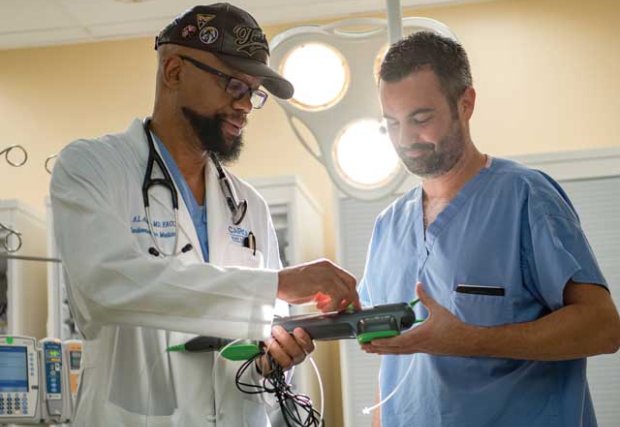Ansermo Arthur, MD, FACC, left, and James Smith, RN, BSN, MHA
As medical director of the catheterization laboratory, Ansermo Arthur, MD, FACC, has worked with Clinical Nurse Manager James Smith, RN, BSN, MHA, to introduce advanced technology and novel medical devices to treat patients with heart and vascular conditions.
Keeping the pace
Unlike conventional pacemakers, the minimally invasive Micra® pacemaker does not require pacing leads or a pacemaker pocket to place the device. It is about an inch long and a quarter-inch wide, and placed directly in the heart through a catheter inserted in a large vein in the groin. “It is indicated for people who have symptoms related to having a slow heart rate or situations where the heart stops momentarily causing similar symptoms,” says Dr. Arthur. “The advantage of this device is its small size, ease of use and no leads to fracture or become infected. That was an occasional problem with conventional pacemakers.”
The Micra takes considerably less time to place, yet has a similar 7- to 10-year battery life to a traditional pacemaker. The Micra can be used in patients of any age, but is particularly suited for older individuals in frail health.
Removing dangerous clots
A medical condition called venous thromboembolism (VTE) causes blood clots to form in the deep veins of the arms, legs or abdomen. When a blood clot develops in a deep vein in the lower leg, thigh or pelvis, it is referred to as a deep vein thrombosis (DVT). “DVTs affect 1 million people every year in the United States,” says Dr. Arthur. “Occasionally, blood clots may break off and lodge in the lungs, causing a pulmonary embolism (PE), which is a dangerous complication of VTE.” Dr. Arthur is using two new devices to remove blood clots in the legs or lungs: the Clot Triever® and Flow Triever®. These devices remove large amounts of clot and reduce many of the complications associated with VTE.
Until recently, there was very little that could be done to remove blood clots in patients presenting these conditions, Dr. Arthur says. “Patients are usually required to take blood thinners, which are not particularly useful in the short term for the person affected by venous thromboembolism,” he says.
Treating peripheral artery disease
Patients with peripheral artery disease often suffer pain when walking — a sign, Dr. Arthur says, that plaque in the arteries has become heavily calcified. “Many of these patients, especially smokers, develop rock-like calcifications in their arteries. But we now have a tool that can remove the hardened plaque,” says Dr. Arthur. “The Diamondback rotational atherectomy catheter has a diamond-coated crown that spins at very high speed, 50,000 to 100,000 rpm. The device is designed to get through these blockages, making them easier to treat.” Once removed, the vessel is more readily expanded with a balloon or stent. This device can also be used to remove hardened plaque in the coronary arteries of the heart. The three devices represent some of the newest medical technology designed to alleviate symptoms, reduce pain and improve longevity in patients with cardiovascular disease, explains Dr. Arthur.
“Despite these advances, cardiovascular disease remains the number one killer of men and women in the United States. The cath lab at Aiken Regional Medical Centers is staffed by a comprehensive team of board-certified cardiologists who continue to explore a broad range of new treatment options to provide patients with heart disease the best care possible,” says Dr. Arthur.
About Ansermo Arthur, MD, FACC
Dr. Arthur has a special interest in the interventional treatment of cardiovascular disease and cerebrovascular disease, which involves the brain and the blood vessels supplying it. He is board certified in Internal Medicine, Cardiovascular Disease and Interventional Cardiology, and has called Aiken Regional Medical Centers home for 25 years.
Dr. Arthur graduated from the University of Arizona College of Medicine. He completed his residency training in internal medicine at Bridgeport Hospital and Yale University School of Medicine in Connecticut. He completed a cardiology fellowship at Brown University School of Medicine in Rhode Island.

